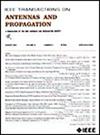From Curved to Planar: Enabling Large-Spacing Phased Array Antenna to Achieve Grating- Lobe-Free Wide-Angle Scanning
IF 4.6
1区 计算机科学
Q1 ENGINEERING, ELECTRICAL & ELECTRONIC
引用次数: 0
Abstract
The phased array antenna (PAA) scanning faces challenges from element spacing requirements to prevent grating lobes, conflicting with the trend toward higher frequencies and cost reduction. Addressing this, this article presents a large-spacing planarized curved array (LSPCA) technology that enables PAAs to achieve grating-lobe-free wide-angle scanning with large spacings. Inspired by the radiation characteristics of Bessel beams in curved arrays, this technology maps a curved array into a large-spacing planar configuration equipped with heterogeneous beam elements (HBEs), inheriting the superior scanning capabilities of the curved format. The study provides theoretical foundations, design methodologies, and experimental validation for this technology. It details the mapping process from curved to planar arrays, examines its wideband characteristics, and evaluates the impact of critical parameters on performance. Experimental validation with two LSPCA configurations confirms the effectiveness of this technology: a从曲面到平面:使大间距相控阵天线实现无光栅loble广角扫描
相控阵天线(PAA)扫描面临着元件间距要求以防止光栅瓣的挑战,这与更高频率和降低成本的趋势相冲突。针对这一问题,本文提出了一种大间距平面化曲面阵列(LSPCA)技术,使PAAs能够实现大间距无光栅瓣的广角扫描。受曲面阵列贝塞尔光束辐射特性的启发,该技术将曲面阵列映射为配备非均匀光束单元(HBEs)的大间距平面构型,继承了曲面格式优越的扫描能力。本研究为该技术提供了理论基础、设计方法和实验验证。它详细介绍了从曲面阵列到平面阵列的映射过程,检查了其宽带特性,并评估了关键参数对性能的影响。两种LSPCA配置的实验验证证实了该技术的有效性:1\ × 8$元阵列显示±75°扫描,平均元件间距为1.06 $ \lambda $,副瓣电平(SLLs)低于- 5 dB,而1\ × 16$元阵列将其扩展到±80°,平均间距为1.27 $ \lambda $, SLLs低于- 8 dB。该技术展示了在大间距下特殊的无光栅瓣广角扫描,并利用公式化设计而不是复杂的优化,为大间距阵列提供了一个有前途的解决方案。
本文章由计算机程序翻译,如有差异,请以英文原文为准。
求助全文
约1分钟内获得全文
求助全文
来源期刊
CiteScore
10.40
自引率
28.10%
发文量
968
审稿时长
4.7 months
期刊介绍:
IEEE Transactions on Antennas and Propagation includes theoretical and experimental advances in antennas, including design and development, and in the propagation of electromagnetic waves, including scattering, diffraction, and interaction with continuous media; and applications pertaining to antennas and propagation, such as remote sensing, applied optics, and millimeter and submillimeter wave techniques

 求助内容:
求助内容: 应助结果提醒方式:
应助结果提醒方式:


